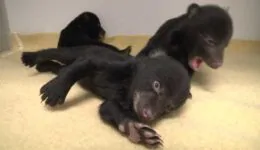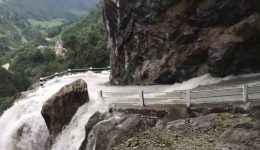Massive Herd of Elk in Montana
This video shows a huge heard crossing the road near Yellowstone. It’s located at Bozeman, MT. We have never seen such a big herd before. Poor little guy at the end. Luckily he finally caught up. What did you think of the elk crossing?
Elk migration in Yellowstone National Park is a fascinating natural phenomenon. Here are some interesting facts about it:
- Seasonal Movement: Elk in Yellowstone undertake one of the longest remaining land mammal migrations in the contiguous United States. They migrate between their winter range in the northern parts of the park and their summer range in the higher elevations of the park.
- Population Size: The northern Yellowstone elk herd is one of the largest herds in North America, with an estimated population of around 10,000 individuals.
- Altitudinal Migration: Elk undertake altitudinal migration, moving from lower elevation winter ranges to higher elevation summer ranges. During winter, they descend to lower valleys where they find milder temperatures and access to food.
- Breeding Season: Elk migration in Yellowstone is influenced by the breeding season, known as the rut, which typically occurs in the fall. During this time, the bulls compete for mating rights by bugling, displaying their antlers, and engaging in physical confrontations.
- Route Selection: The migration routes of elk in Yellowstone are not fixed and can vary from year to year. The selection of routes depends on factors such as snow depth, forage availability, and predator avoidance.
- Natural Barriers: Elk migration routes are sometimes impeded by natural barriers like deep snow or large rivers. These obstacles can influence the timing and success of migration, as elk need to find suitable crossing points.
- Predator-Prey Interaction: The migration of elk in Yellowstone also influences predator behavior. Wolves, Yellowstone’s apex predators, are known to follow the elk herds during migration, targeting weak or injured individuals.
- Ecological Impact: Elk migration plays a vital role in shaping the landscape and maintaining ecological balance in Yellowstone. Their grazing patterns can affect plant growth, and their movements help disperse seeds and nutrients.
- Human-Wildlife Interactions: Elk migration attracts a significant number of visitors to Yellowstone, providing them with opportunities to observe and appreciate this natural spectacle. Park authorities manage traffic and access points to minimize disturbances to the migrating elk.
- Research and Conservation: Scientists study elk migration in Yellowstone to understand the ecological processes and inform conservation efforts. Research helps in evaluating the impacts of climate change, habitat alteration, and human activities on elk populations and their migration patterns.
These fascinating elk migrations in Yellowstone National Park showcase the intricate relationship between wildlife, landscape, and the dynamic processes of nature.
Please let us know in the comment section below and remember to share the video and sign up for our free newsletter!





May 14, 2014 @ 12:48 am
Thick as sheep, One leads the rest follows but at least they care and are loyal to their own, Nice to see.
September 9, 2014 @ 3:11 pm
Yes, Taffy–unlike most humans
May 9, 2014 @ 4:27 pm
darn fence is 3 feet too low
April 17, 2014 @ 4:44 pm
It looked like,to me, that he went through the fence. I was really afraid he wouldnt make it, but I thought the guy in the black car that stopped would help him over
April 16, 2014 @ 4:06 pm
I never saw such a huge herd of elks before. indeed there are no elks here in Belgium.
April 11, 2014 @ 10:28 am
good thing that car came by. scared the youngster back and he figured it ouy from there. Amazing how most animals wait for their young
April 9, 2014 @ 10:07 pm
Why do you think Elk County, Pennsylvania got its name…because of the Elk herds!!!!!!!
Hurrah for the last of the herd. He/she made it!!! and the rest waited for it. Magnificent animals!!!!
April 7, 2014 @ 10:27 pm
Was stationed in Montana.
came around a curve at night. Road was full of Elk. no time for brakes. Closed my eyes, gripped the wheel. Seconds later I was through the herd. Didn’t touch a hair . Amen.
April 7, 2014 @ 6:19 pm
Fern, you’re the retard. It’s a young buck and at the end he found the chutzpah to jump.
April 7, 2014 @ 9:21 pm
Actually, it’s a Bull. A slow Bull.
April 7, 2014 @ 11:21 am
Or, she’s blond?
July 29, 2014 @ 10:12 am
My exact words Fern ^_^
July 29, 2014 @ 10:13 am
🙂 🙂
September 5, 2014 @ 5:14 pm
You are showing your age by using that old incorrect word. Or maybe ……..
April 7, 2014 @ 11:18 am
There’s always 1 retard. Obviously never done that before. Now he knows the combination.
July 25, 2014 @ 8:50 am
Hope you are referring to the car that just couldn’t sit still for a bit. HE is the retard, not the elk. Love to hear the herd call the last straggler. Beautiful video. Thank you for being patient and showing us the conclusion of the last elk. We have lots of elk here in Costilla County, Colorado, but rarely see this many together. We’ve had a few wander into our back yard in the fall.
August 17, 2014 @ 4:00 pm
Could not agree with you more Dee!
August 23, 2014 @ 5:46 pm
Actually, I have to agree with Fern and I believe the impatient driver did the young elk a service by scaring her into running away and then being able to get a running start to make the jump. Sad to say, she will probably be culled by a predator because she is either stupid or not paying attention to what is going on or what needs to be done.
August 27, 2014 @ 7:40 pm
I cheered when the novice caught up with the herd. As for being retarded, based on what he wrote, Fern is the one who is either emotionally or cognitively challenged.